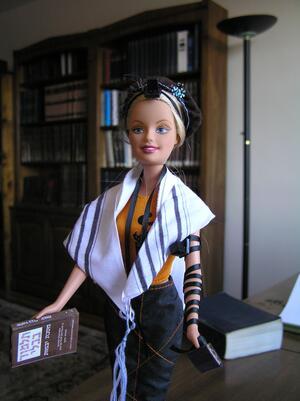A Woman Taught Me to Lay Tefillin
The event was called a “Jewish BLT: Bagel, Lox and Tefillin.” I stood there holding the newly purchased and never used tefillin in my hand as I unfolded the instructions ready to tackle this ancient ritual. It turned out the instructions looked as though they had been written after an office party. Baffled, I held the leather straps, looking for shock and awe more than for Shacharit. A hand touched my shoulder, and my friend Sharona offered to walk me through the process. At each step she slowly, deliberately, and patiently helped me understand not only the how but the why of tefillin. She made sure I could recite the prayers, and in the end I was impressed by the perfect Shin the straps made across my hand.
When the service was over and the bagel and lox came out, a man in the congregation leaned over to me and said, “I still find it weird that women are putting on tefillin.” For this man, it was an uncertain change in the practice of our people.
I was reminded of this experience while using the lesson on "Tefillin Barbie" on the Jewish Women's Archive website. What would that guy think of her or the woman who created her, Jen Taylor Friedman, a Soferet (ritual scribe), who had challenged the age-old male tradition of that profession? Friedman is among the latest in a line of women who are embracing Jewish values and traditions and re-creating them for a new age so that women can fully engage in Jewish life.
For young people, it is easy to forget that the first woman rabbi was ordained in the United States only 40 years ago. Today women are at the helm of a revolution that is helping make ritual, theology, and everyday Judaism more relevant to our contemporary world. Of course, there are also men doing the same thing, but I find myself learning more from the women who are challenging long-held ideas and traditions to create a thriving 21st century Judaism.
I suspect that women have always had something to say about Jewish life, but that only recently has our community allowed the influence of women to be publically acknowledged. I imagine, for example, that the women in the lives of the great Rabbinic sages probably influenced their writing. Today, however, women do not have to hide behind a man to get their voices heard but rather can bring their wisdom into the open.
There are so many examples of women shaping Judaism today. I’m thinking of women like Marcia Falk and the writers and editors at RitualWell.org, who have called on us to reclaim a rich and evolving prayer tradition to find new ways to approach prayer and ritual, giving us options and freedom to find our own words and thoughts. These writers are also creating and sharing new rituals for today’s changing Jewish family, providing a starting place more suited to our contemporary values and ideals.
I’m also thinking of rabbis like my own, Sandy Eisenberg Sasso, the first Rabbi to be a mother, who has written a series of children’s books bringing “God talk” to young children in a way that doesn’t insult the readers’ theology. Her writing gives us a new way to look at childhood spirituality. Another teacher and friend of mine, Rabbi Janie Grackin, explores how the traditions of Judaism can be made fun using socio-dramatic play and shared family events. Her work has enabled many to step outside of their comfort zone and experience Jewish ritual in exciting and lively ways.
There are women like Rabbi Jill Jacobs of Rabbis for Human Rights and Ruth Messinger of American Jewish World Service who challenge us to think about our responsibility to love our neighbor and do righteousness. They teach us that Mitzvah Day is not enough, calling on Jews to do tzedakah and tikkun olam in a meaningful and impactful way. They remind us to focus not only on our own experiences of community service but on what we are actually accomplishing for the people we are trying to serve.
At a recent meeting of Jewish educators, I heard an old axiom about the roles of men and women: “The man is the head, but the woman is the neck; she points the head where she wants it to go.” The Jewish women leaders I see around me demonstrate that women are no longer relegated to being the neck, to peeking through the curtain of the mechitza, to looking down from the balcony, to scrawling notes in the margins of the prayerbook. Women have carved out their place of leadership in American Judaism and are shepherding it into the future.
George Kelley was a participant in JWA's 2011 Summer Institute for Educators. The Education Director at Congregation Beth-El Zedeck in Indianapolis as well as a storyteller and speaker, he does a great deal of work in the interfaith community looking for ways for people to share community without having to give up their differences.






